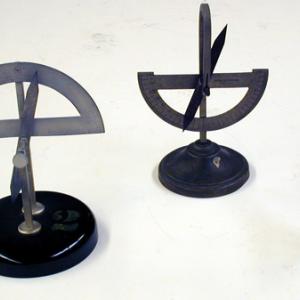College of Liberal Arts & Sciences
5H10.15 - Dip Needle
Align the dip needle with the north/south magnetic poles of the Earth. For our location the dip needles should have an angle of approximately 72 or 73 degrees from the horizontal.
The Pasco dip needle unit is capable of quantitative measurements of the Earth's magnetic field. Instructions for the unit are in the 5H10.15 pdf file folder.
- Leonid Minkin, Daniel Sikes, "Measuring the Magnetic Field Vector of Earth", TPT, Vol. 60, #3, March 2022, p. 200.
- Si Wang, Shiqi Huang, Chenchen Liu, Ziqian Tang, Qingfan Shi, Jurgen Schulte, "A Simple Method to Measure the Local Geomagnetic Field Accurately in a First-Year Physics Laboratory", TPT, Vol. 59, #1, Jan. 2021, p. 44.
- Samuel Derman, "Simple Demonstration of the Earth's Magnetic Field", TPT, Vol. 43, #2, Feb. 2005, p. 68.
- Farhang Amiri and Rondo N. Jeffery, "Simple Experiments to Study the Earth's Magnetic Field", TPT, Vol. 42, #8, Nov. 2004, p. 458.
- Samuel Derman, "A Pointed Demonstration of Surface Tension", TPT, Vol. 29, #6, Sept. 1991, p. 414.
- J. E. Fredrickson, "Magnetic Field of Earth and Magnetic Dipole Moment - An Experiment", AJP, Vol. 43, #2, Feb. 1975, p. 186.
- B-115: "Needle - Floating & Dipping", DICK and RAE Physics Demo Notebook.
- Robert J. Reiland, "Laboratory Activity 9: The Earth's Magnetic Field", Teaching About Magnetism, p. 3.34.
- Isaac Asimov, "Iron, Cold Iron", Fantasy and Science Fiction Magazine.
- Isaac Asimov, "From Pole to Pole", Fantasy and Science Fiction Magazine.
- H.J. Press, "Dip to the Pole", Giant Book of Science Experiments, p. 61.
- Janice VanCleave, "9, Variation", Geography for Every Kid: Easy Activities that Make Learning Geography Fun.
- Janice VanCleave, "13, Back and Forth", Magnets, p. 52.
- Rudolf F. Graf, "Magnetic Dip or Inclination", Safe and Simple Electrical Experiments, p. 60.
- Joseph Frick, "#227 & 228, & 229 - Declination of the Needle & Dip of the Needle & Influence of Terrestrial Magnetism on Iron", Physical Technics: Or Practical Instructions for Making Experiments in Physics and the Construction of Physical Apparatus with the Most Limmited Means, p. 251 & 252.
- D. Colson, C. J. Lapp, J. A. Eldridge, "Experiment LII", 1936 Univ. of Iowa Physics Laboratory Manual, p. 53.
- "Small Dipping Needle with Graduated Arc", Pike's Illustrated Catalogue of Scientific & Medical Instruments, Pike's Illustrated Descriptive Catalogue of Optical, Mathematical, and Philosophical Instruments, 1984, p. 8.
- The Queen Catalogues Vol. II, Catalogue of Physical Instruments, No. 5139, p. 73.
Disclaimer: These demonstrations are provided only for illustrative use by persons affiliated with The University of Iowa and only under the direction of a trained instructor or physicist. The University of Iowa is not responsible for demonstrations performed by those using their own equipment or who choose to use this reference material for their own purpose. The demonstrations included here are within the public domain and can be found in materials contained in libraries, bookstores, and through electronic sources. Performing all or any portion of any of these demonstrations, with or without revisions not depicted here entails inherent risks. These risks include, without limitation, bodily injury (and possibly death), including risks to health that may be temporary or permanent and that may exacerbate a pre-existing medical condition; and property loss or damage. Anyone performing any part of these demonstrations, even with revisions, knowingly and voluntarily assumes all risks associated with them.
